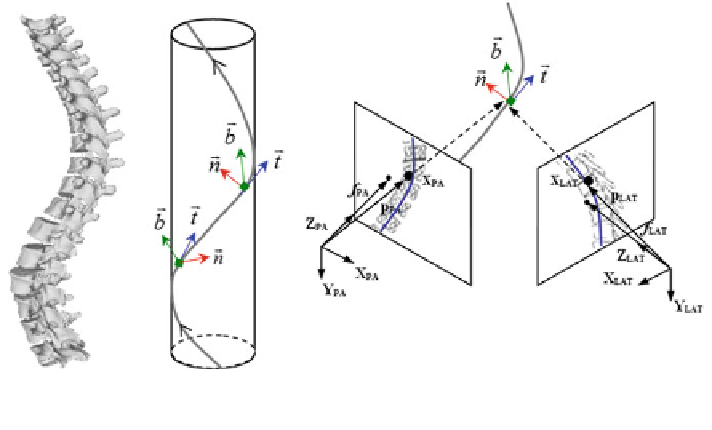Information Technology Reference
In-Depth Information
Hence, the visual hull is the maximal object that has the same silhouettes as the
original object, as viewed from the viewing region. The segmented object and spine
silhouettes are projected into the 3D space by conical visual hulls in the projective
projection model, and its projection should coincide with its silhouette on
X
such
that
P
i
s
i
. By computing the intersection of the visual hulls projected from
both images (i.e. biplanar viewing directions), the estimation for the shape of the
spine is obtained according to the current projection parameters
P
i
.
ð
S
Þ
¼
3.3.2 Geometric Torsion of the Scoliotic Spine
Due to the 3D nature of idiopathic scoliosis, the natural curvature properties of the
spinal curve can also exploited in the re
ned optimization of the radiographic
parameters, by using the geometrical torsion of the spine measuring the amount of
deviation (divergence) of the curved line from the plane determined by the tangent
t and normal n vectors [
51
]. In scoliosis, geometric torsion is related to the amount of
helicoidal deformity in the spine. It can be de
ned as a local geometric property of
the 3D curved line passing through thoracic and lumbar vertebrae that measures
the amount of helicoidal deviation of the vertebrae, without speci
c relation to the
rotation and deformation of the vertebrae themselves. The continuous parametric 3D
B-spline spinal curve C
k
ð
3
u
Þ2<
that passes through the center of the spine was
represented by Frenet
s formulas in order to calculate the geometric torsion as
portrayed in Fig.
7
. Ultimately, 2D-3D correspondences and a derived relationship
which uses Frenet frames to extract 2D information from the image curves are used,
and compute their 3D measurements. First, let
a
i
ð
'
u
Þ
be a regular curve parameterized
Fig. 7 The scoliotic spine represented as a helical line which can be uniquely determined by its
geometric torsional quantity. The concept of geometric torsion (
s
) is illustrated by the moving
trihedron formed by the tangential t, normal n, and binormal b vectors

